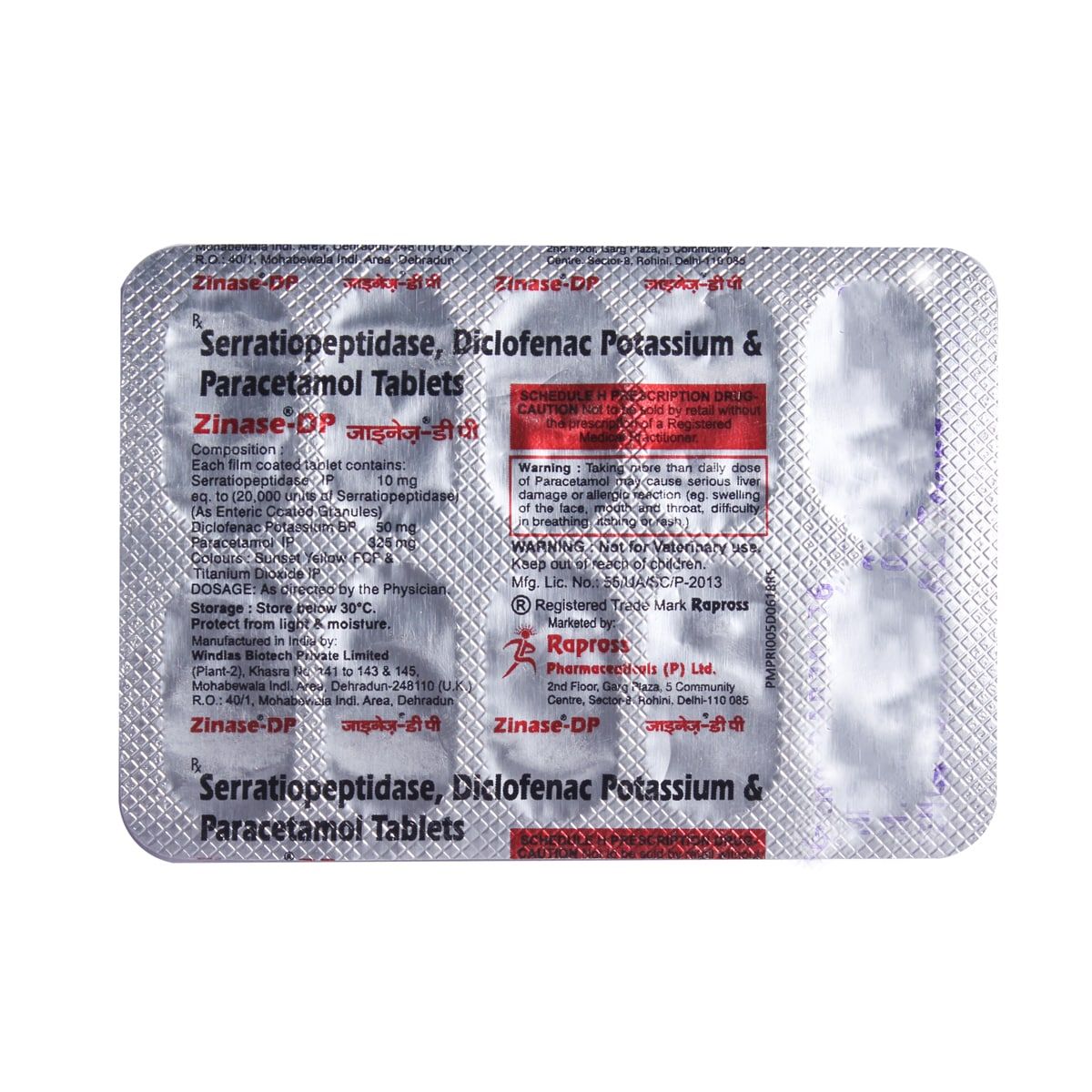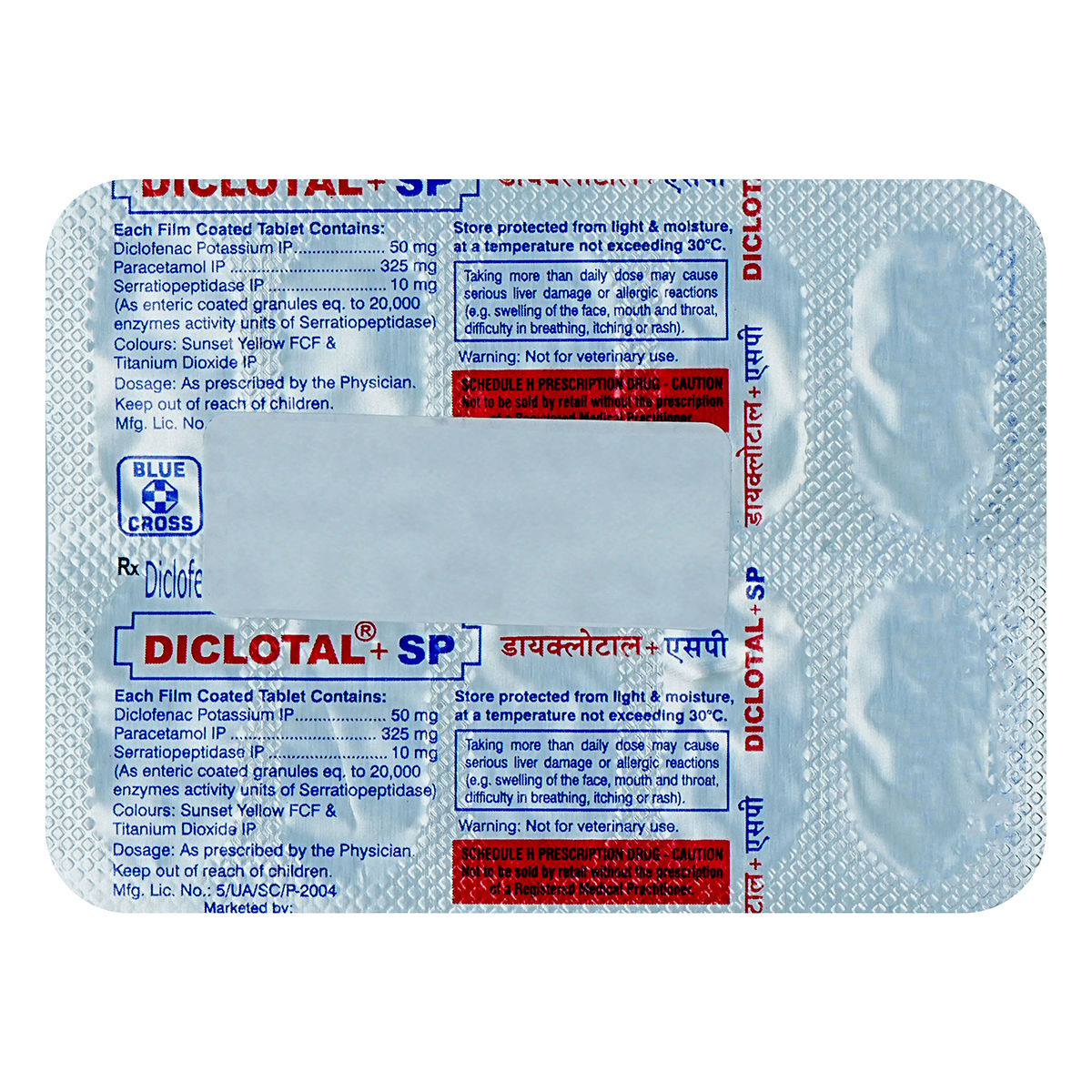Diase P Tablet 10's

₹71.1*
MRP ₹79
10% off
₹67.15*
MRP ₹79
15% CB
₹11.85 cashback(15%)
Free Delivery
With Circle membership
(Inclusive of all Taxes)
This offer price is valid on orders above ₹800. Apply coupon PHARMA10/PHARMA18 (excluding restricted items)
Diase P Tablet is used to relieve pain and inflammation in conditions like osteoarthritis, rheumatoid arthritis, and ankylosing spondylitis. Besides this, it also helps treat muscle pain, tooth pain during dental surgery, menstrual cramps, ear pain, and migraine headaches. It reduces mild to moderate pain, inflammation and fever, decreasing swelling at the painful site. It may cause common side effects such as nausea, vomiting, stomach pain, headache, indigestion and diarrhoea. Before taking this medicine, you should tell your doctor if you are allergic to any of its components or if you are pregnant/breastfeeding, and about all the medications you are taking and pre-existing medical conditions.
Know Your Delivery Time
Provide Delivery Location
 Prescription drug
Prescription drugWhats That

Secure Payment

India's Most Trusted Pharmacy

Genuine Products
Manufacturer/Marketer :
Consume Type :
Return Policy :
Expires on or after :
About Diase P Tablet
Diase P Tablet is used to relieve pain and inflammation in conditions like osteoarthritis, rheumatoid arthritis, and ankylosing spondylitis. Besides this, it also helps treat muscle pain, tooth pain during dental surgery, menstrual cramps, ear pain, and migraine headaches. Pain is a symptom triggered by the nervous system, causing uncomfortable sensations in the body. Arthritis is characterised by tenderness and swelling in the joints, causing pain and joint stiffness.
Diase P Tablet is a combination of three drugs, namely: Diclofenac, Paracetamol and Serratiopeptidase. Diclofenac and Paracetamol work by blocking the effect of cyclooxygenase (COX) enzymes, which produce other chemical prostaglandins. These prostaglandins are produced at injury sites and cause pain, swelling and fever. By blocking the COX enzyme's effect, fewer prostaglandins are produced, which reduces mild to moderate pain, inflammation and fever. Serratiopeptidase acts as a mucolytic agent, dissolving thick proteins at the injured or affected site, and as an anti-inflammatory agent, thereby decreasing swelling at the painful site.
You are advised to take Diase P Tablet for as long as your doctor has prescribed it for you. In some cases, Diase P Tablet may cause specific common side effects such as nausea, vomiting, stomach pain, headache, indigestion and diarrhoea. Most of these side effects do not require medical attention and will resolve gradually over time. However, you are advised to talk to your doctor if you experience these side effects persistently.
Consult your doctor if you are pregnant or breastfeeding. Diase P Tablet may cause drowsiness and dizziness, so drive with caution. Diase P Tablet should not be given to children as safety and efficacy have not been established. Avoid consuming alcohol with Diase P Tablet as it could lead to increased drowsiness and dizziness; it might also increase the risk of stomach bleeding. Keep your doctor informed about your health condition and any medications you're taking to rule out any side effects or interactions.
Uses of Diase P Tablet
Directions for Use
- Diase P Tablet should be taken after meals, to reduce the likelihood of gastrointestinal side effects.
- Recommended to take Diase P Tablet once daily or as advised by your doctor.
- Administer Diase P Tablet as a whole orally with water.
- Avoid crushing, breaking, or chewing Diase P Tablet .
Medicinal Benefits
Diase P Tablet is a combination of three drugs: Diclofenac (a painkiller), Paracetamol (a fever reducer), and Serratiopeptidase (a protein enzyme). Diase P Tablet is used to relieve pain and inflammation associated with osteoarthritis, rheumatoid arthritis, ankylosing spondylitis, muscle pain, tooth pain, bone and joint pain, headache, swelling, period pain, ear pain, migraine, fever, sore throat, nose pain, etc. Diase P Tablet increases the pain threshold and blood flow across the skin. Diclofenac and Paracetamol work by blocking the effect of chemical messengers that cause pain and inflammation. Serratiopeptidase breaks down the abnormal proteins at the site of inflammation, thereby reducing inflammation.
How Diase P Tablet Works
Storage
What if I have taken an overdose of Diase P Tablet
Drug Warnings
Do not take Diase P Tablet if you are allergic to paracetamol, diclofenac or serratiopeptidase, have/had severe heart problems, stomach ulcer or perforation, bleeding problems such as bleeding from the stomach, intestine or brain, have undergone any heart bypass surgery, have had a heart attack, blood circulation problems or inflammation of intestines. Consult your doctor if you are pregnant, planning for pregnancy or breastfeeding. Diase P Tablet may cause drowsiness and dizziness, so drive only if you are alert. Diase P Tablet is not recommended for children less than 10 years of age as safety and effectiveness have not been established. Avoid consuming alcohol with Diase P Tablet as it could lead to increased drowsiness and increased risk of stomach bleeding. Stop taking Diase P Tablet and consult your doctor immediately if you have stomach pain or any signs of bleeding in the intestine or stomach, such as blood in stools. Do not take any other NSAIDs for pain relief along with Diase P Tablet unless prescribed.
Drug-Drug Interactions
Drug-Drug Interactions
Login/Sign Up
Co-administration of Diase P Tablet with Meloxicam can increase the risk or severity of gastrointestinal side effects.
How to manage the interaction:
Taking Meloxicam with Diase P Tablet is not recommended as it can possibly result in an interaction, it can be taken if your doctor has advised it. However, consult your doctor immediately if you experience symptoms such as dizziness, lightheadedness, red or black, tarry stools, coughing up or vomiting fresh or dried blood that looks like coffee grounds, severe headache, and weakness. Do not stop any medication without doctor's advise.
Taking Diase P Tablet and ibuprofen can increase the risk of stomach bleeding and ulcers.
How to manage the interaction:
Co-administration of Diase P Tablet and Ibuprofen can lead to an interaction, it can be taken if advised by your doctor. However, if you experience any symptoms like unusual bleeding or bruising, dizziness, lightheadedness, red or black, tarry stools, coughing up or vomiting fresh or dried blood that looks like coffee grounds, severe headache, and weakness, consult your doctor immediately. Do not stop using any medications without a doctor's advice.
Co-administration use of Diase P Tablet with Dalteparin may increase the risk of bleeding complications.
How to manage the interaction:
Although taking Dalteparin with Diase P Tablet may possibly lead to an interaction, they can be taken if a doctor prescribes it. Consult a doctor if you have any symptoms including dizziness, lightheadedness, red or black, tarry stools, coughing up or vomiting fresh or dried blood that resembles coffee grounds, severe headache, and weakness. Without consulting a doctor, never stop taking any medication.
Co-administration of Diase P Tablet with tenofovir disoproxil may increase the risk of developing kidney problems.
How to manage the interaction:
There may be a possible interaction between Diase P Tablet and Tenofovir disoproxil but they can be taken together if your doctor has prescribed them. However consult your doctor immediately if you experience symptoms such as such as nausea, vomiting, loss of appetite, increased or decreased urination, sudden weight gain or weight loss, swelling, shortness of breath, bone pain, muscle cramps, tiredness, weakness, dizziness, confusion, and irregular heart rhythm. Do not stop using any medications without first talking to your doctor.
Co-administration of Diase P Tablet and tenofovir alafenamide may cause kidney problems.
How to manage the interaction:
There may be a possible interaction between Diase P Tablet and Tenofovir alafenamide but they can be taken together if your doctor has prescribed them. However, consult your doctor immediately if you experience symptoms such as such as nausea, vomiting, loss of appetite, increased or decreased urination, sudden weight gain or weight loss, fluid retention, swelling, shortness of breath, bone pain, muscle cramps, tiredness, weakness, dizziness, confusion, and irregular heart rhythm. Do not stop using any medications without talking to your doctor.
The combined use of Diase P Tablet and Indomethacin can increase the risk of stomach bleeding and ulcers.
How to manage the interaction:
Co-administration of Diase P Tablet and Indomethacin can lead to an interaction, it can be taken if advised by your doctor. However, if you experience any symptoms like unusual bleeding or bruising, dizziness, lightheadedness, red or black, tarry stools, coughing up or vomiting fresh or dried blood that looks like coffee grounds, severe headache, and weakness, consult a doctor immediately. Do not stop using any medications without a doctor's advice.
Taking Diase P Tablet with warfarin may, increase the risk of bleeding.
How to manage the interaction:
There may be a possible interaction between Diase P Tablet and Warfarin, but they can be taken together if a doctor has prescribed them. However, consult your doctor immediately if you experience unusual bleeding or bruising, vomiting, blood in your urine or stools, headache, dizziness, or weakness, contact a doctor. Do not discontinue any medications without consulting a doctor.
Coadministration of Diase P Tablet with cidofovir may increase the risk of kidney problems.
How to manage the interaction:
Although taking Diase P Tablet and cidofovir together can possibly cause an interaction, it can be taken if your doctor has suggested it. However, if you experience nausea, vomiting, loss of hunger, increased or decreased urination, sudden weight gain or loss, fluid retention, swelling, shortness of breath, muscle cramps, tiredness, weakness, dizziness, confusion, or an irregular heart rhythm, consult a doctor. Do not discontinue any medications without consulting a doctor.
Coadministration of Diase P Tablet and Naproxen can increase the risk or severity of side effects.
How to manage the interaction:
Taking Diase P Tablet and Naproxen together can possibly result in an interaction, it can be taken if your doctor has advised it. However, if you notice any unusual bleeding or bruising, other signs of bleeding, dizziness, lightheadedness, red or black tarry stools, coughing up or vomiting blood, severe headache, and weakness, you should contact your doctor immediately. Do not stop using any medications without first talking to your doctor.
Taking Valdecoxib with Diase P Tablet may increase risk of side effects.
How to manage the interaction:
There may be a possible interaction between Diase P Tablet and Valdecoxib but can be taken if prescribed by doctor. However, consult your doctor immediately if you experience any unusual bleeding or bruising or have other signs and symptoms of bleeding such as dizziness, lightheadedness, red or black, tarry stools, coughing up or vomiting fresh or dried blood that looks like coffee grounds, severe headache, and weakness. Do not stop any medications without consulting a doctor.
Drug-Food Interactions
Drug-Food Interactions
Login/Sign Up
Diet & Lifestyle Advise
- Exercising regularly helps in muscle stretching so that they are less likely to spasm, tear and sprain. Mild exercises such as jogging and walking are helpful for muscle stretching.
- Massages can also be helpful.
- Avoid freezing and hot temperatures.
- Avoid wearing tight-fitting clothes; instead, wear loose garments.
- Rest well, and get plenty of sleep.
- To prevent pressure sores, change your position every 2 hours.
- Hot or cold therapy can help treat muscle spasms. Apply an ice pack or hot pack on the muscle for 15-20 minutes.
- Stay hydrated, drink plenty of water.
Habit Forming
Therapeutic Class
Product Substitutes
Alcohol
Unsafe
Avoid consumption of alcohol while taking Diase P Tablet as it may cause increased drowsiness.
Pregnancy
Caution
Please consult your doctor if you are pregnant; your doctor will prescribe Diase P Tablet only if the benefits outweigh the risks.
Breast Feeding
Caution
Consult your doctor if you are breastfeeding; your doctor will decide whether Diase P Tablet can be taken by breastfeeding mothers or not.
Driving
Caution
Diase P Tablet may cause dizziness and drowsiness. Do not drive or operate machinery unless you are alert.
Liver
Caution
Dose adjustment may be needed in patients with liver impairment. Please consult your doctor if you have a liver impairment or any concerns regarding this.
Kidney
Caution
Dose adjustment may be needed in patients with kidney impairment. Please consult your doctor if you have kidney impairment or any concerns regarding this.
Children
Unsafe
Diase P Tablet should not be given to children less than 10 years of age, as the safety and effectiveness have not been established.

Have a query?
FAQs
Diase P Tablet is used to relieve pain and inflammation in conditions like osteoarthritis, rheumatoid arthritis, and ankylosing spondylitis. Besides this, it also helps treat muscle pain, tooth pain during dental surgery, menstrual period pain/cramps, ear pain and migraine headaches.
Diase P Tablet contains Diclofenac, Paracetamol and Serratiopeptidase. Diclofenac and Paracetamol work by blocking the effect of chemical messengers that cause pain and inflammation. Serratiopeptidase is a protein enzyme that helps break down and dissolves the abnormal proteins at the inflammation site, thereby reducing pain.
Diase P Tablet is used to reduce and relieve pain and inflammation associated with osteoarthritis, rheumatoid arthritis and ankylosing spondylitis. Arthritis is the tenderness and swelling in the joints.
Diarrhoea might be a side-effect of Diase P Tablet . Drink enough fluids and eat non-spicy food if you experience diarrhoea. If you find blood in stools (tarry stools) or if you experience severe diarrhoea, consult your doctor. Do not take anti-diarrheal medicine on your own.
Diase P Tablet should not be taken for longer durations unless prescribed by the doctor. If Diase P Tablet has been prescribed for longer durations, regular monitoring of kidney function, liver function and blood count is advised, particularly in elderly patients.
Avoid taking Diase P Tablet if you have ulcers in the stomach or intestines, bleeding problems or heart problems.
No, you should not use the Diase P Tablet if you have stomach ulcers. Diase P Tablet can irritate the stomach lining, worsen existing stomach ulcers, or even cause new ones to develop. If you have stomach ulcers, it's essential to consult with your doctor to discuss appropriate treatment options.
No, Diase P Tablet is not a muscle relaxant.
The amount and frequency of your medication can vary depending on your health, age, and other medications you're taking. Always follow your healthcare professional's directions to use this medicine safely and correctly.
Yes, Diase P Tablet contains diclofenac, which is a nonsteroidal anti-inflammatory drug (NSAID).
Store in a cool and dry place away from sunlight. Keep Diase P Tablet out of the sight and reach of children.
Diase P Tablet can be safe when used as directed by a healthcare professional. However, like all medications, it has potential side effects and may interact with other medicines. It's important to consult with a doctor or pharmacist before starting or continuing to use this medication. They can assess your health situation and determine if it suits you.
Even if the pain is alleviated, this does not necessarily imply that the underlying condition has healed completely. Stopping the medicine prematurely may result in a return of your symptoms.
Yes, Diase P Tablet can cause nausea and vomiting. These are common side effects of the medication, especially when taken on an empty stomach or in high doses. If nausea or vomiting is persistent or severe, it's important to seek medical attention.
Yes, Diase P Tablet can cause dizziness. It is a common side effect of the medication, especially when starting the medication or taking a higher dose. If dizziness is persistent or severe, seeking medical attention is essential.
It is generally safe to use Diase P Tablet with Vitamin B-Complex. However, you should always discuss with your doctor or pharmacist before combining any medications, especially if you have underlying health concerns or are taking other prescriptions. They can evaluate potential interactions and confirm that the combination is safe for you.
No, you should not take Diase P Tablet for stomach pain. If you have stomach pain, you should consult a doctor to find out what's causing it and get the right therapy.
Yes, the use of Diase P Tablet may cause damage to the kidneys. This may occur in some people, especially those at risk for kidney problems. If you are concerned about your risk of kidney damage while taking Diase P Tablet , it's essential to talk to your doctor. They can monitor your kidney function, adjust your dosage, or recommend alternative medications if necessary.
Use of Diase P Tablet during pregnancy is not advised unless prescribed by a doctor. Please consult your doctor if you are pregnant; your doctor will prescribe Diase P Tablet only if the benefits outweigh the risks.
Common side effects of Diase P Tablet may cause nausea, vomiting, stomach pain, headache, indigestion and diarrhoea. Most of these side effects do not require medical attention and will resolve gradually over time. However, you are advised to talk to your doctor if you experience these side effects persistently.
Diase P Tablet may be unsafe for some people based on their medical condition. So please inform your doctor about your medical conditions and medications. Your doctor will decide whether it is suitable for you or not.
Diase P Tablet may interact with various medications. So, seek personalized medical guidance from your healthcare professional by knowing about all your medications.
Store in a cool and dry place away from sunlight. Keep Diase P Tablet out of reach and out of sight to children.
Taking Diase P Tablet with food is generally recommended to reduce the risk of stomach upset.
Country of origin
Manufacturer/Marketer address
Disclaimer
Author Details
We provide you with authentic, trustworthy and relevant information
Reference
Buy best C.n.s Drugs products by
ANTI CONVULSANTS
NSAID'S
ANALGESICS & ANTIPYRETICS
ANTI DEPRESSANTS
MUSCLE RELAXANT
NARCOTICS & PSYCHOTROPIC AGENTS
ANXIOLYTICS & SEDATIVES
CEREBRAL ACTIVATORS
ANTI VERTIGO
ANTI EMETICS
ANTI MIGRAINE
ANTI PARKINSON'S DRUGS
ANTIRHEUMOTOID DRUGS
NEUROMUSCULAR DRUGS
OTHER C.N.S DRUGS
ARTHRITIS
GASTRITIS, REFLUX & ULCERS
TOPICAL NSAID'S
ANTI CONVULSANTS
NSAID'S
ANALGESICS & ANTIPYRETICS
ANTI DEPRESSANTS
MUSCLE RELAXANT
NARCOTICS & PSYCHOTROPIC AGENTS
ANTI ANXIETY
TOPICAL NSAID'S
CEREBRAL ACTIVATORS
ANTI VERTIGO
ANTI EMETICS
ANTI MIGRAINE
SEDATIVES
ANTI PARKINSON'S DRUGS
NEUROMUSCULAR DRUGS
OTHER C.N.S DRUGS
ANTIRHEUMATOID DRUGS
GASTRITIS, REFLUX & ULCERS
Intas Pharmaceuticals Ltd
Sun Pharmaceutical Industries Ltd
Torrent Pharmaceuticals Ltd
Alkem Laboratories Ltd
Abbott India Ltd
Cipla Ltd
Alteus Biogenics Pvt Ltd
Micro Labs Ltd
Lupin Ltd
Ipca Laboratories Ltd
D D Pharmaceuticals Pvt Ltd
Tripada Healthcare Pvt Ltd
Mankind Pharma Pvt Ltd
Arinna Lifesciences Ltd
Linux Laboratories Pvt Ltd
Icon Life Sciences
East West Pharma India Pvt Ltd
La Renon Healthcare Pvt Ltd
Cnx Health Care Pvt Ltd
Talent India Pvt Ltd
Eris Life Sciences Ltd
Leeford Healthcare Ltd
Tas Med India Pvt Ltd
Zydus Healthcare Ltd
Emcure Pharmaceuticals Ltd
Macleods Pharmaceuticals Ltd
Dr Reddy's Laboratories Ltd
Aristo Pharmaceuticals Pvt Ltd
Consern Pharma Ltd
Sigmund Promedica
Troikaa Pharmaceuticals Ltd
Zydus Cadila
Ardent Life Sciences Pvt Ltd
Shine Pharmaceuticals Ltd
Wockhardt Ltd
Crescent Formulations Pvt Ltd
Theo Pharma Pvt Ltd
Matias Healthcare Pvt Ltd
Propel Healthcare
Ikon Pharmaceuticals Pvt Ltd
Jagsam Pharma
Morepen Laboratories Ltd
Reliance Formulation Pvt Ltd
Ajanta Pharma Ltd
Neon Laboratories Ltd
Capital Pharma
Msn Laboratories Pvt Ltd
Akumentis Healthcare Ltd
Matteo Health Care Pvt Ltd
Med Manor Organics Pvt Ltd
Pulse Pharmaceuticals
Elder Pharmaceuticals Ltd
Sanofi India Ltd
Hetero Healthcare Pvt Ltd
Mesmer Pharmaceuticals
Solvate Laboratories Pvt Ltd
Lyf Healthcare
Cyrus Remedies Pvt Ltd
Medishri Healthcare Pvt Ltd
Novartis India Ltd
Crescent Therapeutics Ltd
Mova Pharmaceutical Pvt Ltd
Psyco Remedies Ltd
Alniche Life Sciences Pvt Ltd
Tripada Lifecare Pvt Ltd
Cadila Healthcare Ltd
Glenmark Pharmaceuticals Ltd
Hbc Life Sciences Pvt Ltd
Solis Pharmaceuticals
Alembic Pharmaceuticals Ltd
Brainwave Healthcare Pvt Ltd
Lifecare Neuro Products Ltd
Sanix Formulation Pvt Ltd
Infivis Life Care
Talin Remedies Pvt Ltd
Crescent Pharmaceuticals
Primus Remedies Pvt Ltd
Gagnant Healthcare Pvt Ltd
Kivi Labs Ltd
Medopharm Pvt Ltd
Wallace Pharmaceuticals Pvt Ltd
Blue Cross Laboratories Pvt Ltd
Cadila Pharmaceuticals Ltd
Corona Remedies Pvt Ltd
Jenburkt Pharmaceuticals Ltd
Maneesh Pharmaceuticals Ltd
Quince Lifesciences Pvt Ltd
Trion Pharma India Llp
USV Pvt Ltd
Zuventus Healthcare Ltd
A N Pharmacia Laboratories Pvt Ltd
Ozone Pharmaceuticals Ltd
Pfizer Ltd
Lia Life Sciences Pvt Ltd
Lincoln Pharmaceuticals Ltd
Prevego Healthcare & Research Pvt Ltd
Aareen Healthcare Pvt Ltd
Dycine Pharmaceuticals
Gladstone Pharma India Pvt Ltd
Mano Pharma
Medley Pharmaceuticals Ltd
RPG Life Sciences Ltd
Vasu Organics Pvt Ltd
Apex Laboratories Pvt Ltd
FDC Ltd
Galaxus Pharmaceuticals
Lyceum Life Sciences Pvt Ltd
Arbour Biotec Pvt Ltd
Glarizonto Pharma Pvt Ltd
Knoll Healthcare Pvt Ltd
Overseas Health Care Pvt Ltd
Strides Shasun Ltd
Unimarck Healthcare Pvt Ltd
Wings Pharmacuticals Pvt Ltd
Comed Chemicals Ltd
Divine Savior Pvt Ltd
Ikon Pharmachem
Kiosence Health Care Pvt Ltd
Systopic Laboratories Pvt Ltd
Unichem International
Walnut Life Sciences Pvt Ltd
Arches Pharmaceuticals
Centaur Pharmaceuticals Pvt Ltd
Gentech Healthcare Pvt Ltd
GlaxoSmithKline Pharmaceuticals Ltd
Health N U Therapeutics Pvt Ltd
Kuresys Labs Pvt Ltd
LA Pharma
Nicholas Piramal India Ltd
Startos Healthcare Pvt Ltd
Suraksha Pharma Pvt Ltd
Unison Pharmaceuticals Pvt Ltd
Biochem Pharmaceutical Industries Ltd
Avis Lifecare Pvt Ltd
Geno Pharmaceuticals Pvt Ltd
Lakarez Pharmaceuticals Pvt Ltd
Serotonin Pharmaceuticals Llp
Stature Life Sciences Pvt Ltd
Hansh Pharmaceuticals
Madbris Lifesciences Pvt Ltd
Megma Healthcare Pvt Ltd
Sbs Biotech
Septalyst Lifesciences Pvt Ltd
Starus Pharmaceuticals
Indoco Remedies Ltd
Myk Pharmaceuticals Ltd
Olcare Laboratories Pvt Ltd
Pristine Pearl Pharma Pvt Ltd
Treatsure Pharma
Anglo French Drugs & Industries Ltd
Chemo Healthcare Pvt Ltd
J B Chemicals & Pharmaceuticals Ltd
Ordain Health Care Global Pvt Ltd
Psychocare Health Pvt Ltd
Sparsh Remedies Pvt Ltd
Auspharma Pvt Ltd
Biozen Health Products Pvt Ltd
Icarus Health Care Pvt Ltd
Johnson & Johnson Pvt Ltd
Meyer Organics Pvt Ltd
Snig Pharmaceuticals Pvt Ltd
Viltis Pharma Pvt Ltd
Yuventis Pharmaceuticals
Arvincare
Eysys Pharmaceutical Pvt Ltd
Obsurge Biotech Ltd
Ucb India Pvt Ltd
Biochemix Health Care Pvt Ltd
HEVEREN HEALTHCARE PVT LTD
Laborate Pharmaceuticals India Ltd
Sovyyn Pharmaceuticals
Alna Biotech Pvt Ltd
Eisai Pharmaceuticals India Pvt Ltd
German Remedies Ltd
Helen Pharmaceuticals
Johnlee Pharmaceuticals Pvt Ltd
Knoll Pharmaceuticals Ltd
Orsim Pharma
Themis Pharmaceutical Ltd
Torcium Biotech Pvt Ltd
Unipark Biotech Pvt Ltd
Vrddhi Life Sciences
Wanbury Ltd
Adonis Laboratories Pvt Ltd
Albert David Ltd
Alienist Pharmaceutical Pvt Ltd
Canviko Healthcare Pvt Ltd
Delcure Life Sciences Ltd
Humbing Ethicals
Ishjas Pharma Pvt Ltd
Medgen Drugs And Laboratories Pvt Ltd
Samarth Life Sciences Pvt Ltd
Skn Organics Pvt Ltd
Solas Healthcare
Themis Medicare Ltd
Unichem Laboratories Ltd
Winmark Healthcare Pvt Ltd
Alarta Pharmaceuticals
Alathea Biotec Pvt Ltd
Arrient Healthcare Pvt Ltd
Dhamus Pharma
Glial Life Science Llp
Glorior Biotech Pvt Ltd
Healing Pharma
Intra Life Pvt Ltd
Jagsonpal Pharmaceuticals Ltd
Lloyd Healthcare Pvt Ltd
Pharma Fabrikon
Pills India Lifecare Solutions
Ranbaxy Laboratories Ltd
Regenix Drugs Ltd
Rhine Biogenics Pvt Ltd
Seagull Pharmaceutical Pvt Ltd
Steris Healthcare
Tesla Labs
URENUS PHARMACEUTICALS PVT LTD
Vanprom Lifesciences Pvt Ltd
Walton Health Care Pvt Ltd
Zee Laboratories Ltd
Adivis Pharma Pvt Ltd
An Pharmaceuticals Pvt Ltd
Bion Therapeutics (I) Pvt Ltd
C'Estlavie Pharma
Cognyzon Pharmaceuticals
Dolvis Bio Pharma Pvt Ltd
East India Pharmaceutical Works Ltd
Elbrit Life Sciences Pvt Ltd
Ideal Life Sciences Pvt Ltd
Kepler Healthcare Pvt Ltd
Larion Life Sciences Pvt Ltd
Mitis Biomedics Ltd
OPINOR PHARMACEUTICALS PVT LTD
Pharmed Ltd
Psychotropics India Ltd
Ronyd Healthcare Pvt Ltd
Serum Institute Of India Pvt Ltd
Silver Cross Medisciences Pvt Ltd
Siskan Pharma Pvt Ltd
Unimarck Pharma India Ltd
Zenolia Life Science Pvt Ltd
Anax Life Sciences Pvt Ltd
Arkson Pharmaceuticals
Aurz Pharmaceutical Pvt Ltd
Force India Pharma
Geneaid Pharmaceuticals
Helios Pharmaceuticals
Hetero Drugs Ltd
Lotus Life Sciences
Race Pharmaceuticals Pvt Ltd
Saanso Pharma Pvt Ltd
Saffron Therapeutics Pvt Ltd
Salas Pharmaceuticals
Signova Pharma
Silok Pharmaceuticals
Win Medicare Ltd
Aar Ess Remedies Pvt Ltd
Apellon Biotech
Auxesis Pharmaceuticals Pvt Ltd
Cycus Healthcare Pvt Ltd
Ernst Pharmacia
Hauz Pharma Pvt Ltd
Hymax Healthcare Pvt Ltd
Invision Medi Sciences Pvt Ltd
Kinesis Pharmaceuticals Pvt Ltd
Macway Biotech Pvt Ltd
Maverick Pharma Pvt Ltd
Medsol India Overseas Pvt Ltd
Meglife Pharmaceuticals Pvt Ltd
Mindwin Life Sciences Pvt Ltd
Oxpro Pharma Pvt Ltd
Q Check Pharmaceuticals
Skylane Pharmaceuticals
Stance Biogenics Pvt Ltd
Systemic Healthcare
Uniprixx Laboratories Pvt Ltd
Ventus Pharma
Veritaz Healthcare Ltd
3M India Ltd
DR Johns Lab Pharma Pvt Ltd
Delvin Formulations (P) Ltd
Dr Moni Pharmaceuticals Pvt Ltd
Ficus Remedies
Galpha Laboratories Ltd
Grandcure Healthcare Pvt Ltd
Ivy Healthcare Infrastructure Pvt Ltd
Levin Life Sciences Pvt Ltd
Lividus Pharmaceuticals Pvt Ltd
Mascot Health Series Pvt Ltd
Medtas Healthcare
Meridian Enterprises Pvt Ltd
Midas Health Care
Neurolife Pharmaceuticals Pvt Ltd
Olamic Pharma Pvt Ltd
Peakmed Lifecare Enterprise
SMC HEALTHCARE PVT LTD
Solveig Life Sciences Pvt Ltd
Xemex Life Sciences
Zota Health Care Ltd
Agm Biotech Pvt Ltd
Aspen Pharmaceutical Pvt Ltd























